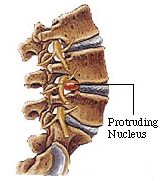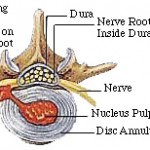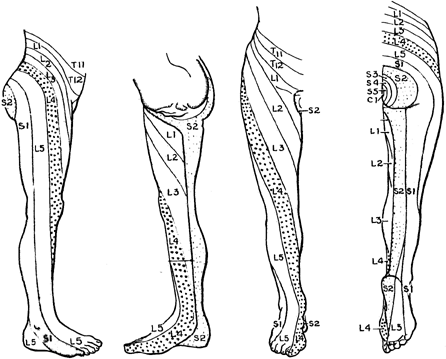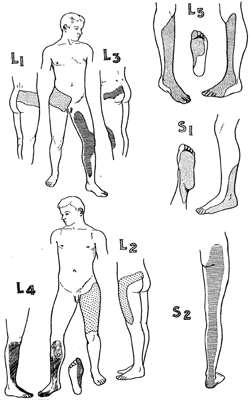Lower back pain can vary from dull pain that develops gradually to sudden, sharp or persistent pain felt below the waist. Unfortunately, almost everyone, at some point during life will experience lower back pain. The most common cause is muscle strain often related to heavy physical labor, lifting or forceful movement, bending or twisting into awkward positions, or standing in one position too long.
Other Causes of Lower Back Pain
There are many different conditions that cause or contribute to lower back pain. Many involve nerve compression (eg, pinched nerve) that may generate pain and other symptoms. Types of spinal disorders include trauma-related and degenerative; meaning age-related. Some of these spinal problems are listed below.
Bulging or herniated disc.
A disc may bulge outward. A herniated disc occurs when the soft interior matter escapes through a crack or ruptures through the disc’s protective outer layer. Both disc problems can cause nerve compression, inflammation, and pain.
Spinal stenosis develops when the spinal canal or a nerve passageway abnormally narrows.
Spinal arthritis, also called spinal osteoarthritis or spondylosis, is a common degenerative spine problem. It affects the spine’s facet joints and may contribute to the development of bone spurs.
 Spondylolisthesis occurs when a lumbar (low back) vertebral body slips forward over the vertebra below it.
Spondylolisthesis occurs when a lumbar (low back) vertebral body slips forward over the vertebra below it.
Vertebral fractures (burst or compression types) are often caused by some type of trauma (eg, fall).
Symptoms:
Mechanical Pain
Mechanical pain is the general term that refers to any type of back pain caused by placing abnormal stress and strain on muscles of the vertebral column. Typically, mechanical pain results from bad habits, such as poor posture, poorly-designed seating, and incorrect bending and lifting motions.
Spinal cord compression pain
Injuries and disorders can put pressure on the spinal cord, causing back pain, tingling, muscle weakness, and other symptoms.The spinal cord may be compressed by bone, blood (hematomas), pus (abscesses), tumors (cancerous or not), or a ruptured or herniated disk. Symptoms, such as back pain, abnormal sensations, muscle weakness, or impaired bladder and bowel control, may be mild or severe.
 Dermatomes: A dermatome is an area of skin supplied by fibers from a single spinal nerve root.
Dermatomes: A dermatome is an area of skin supplied by fibers from a single spinal nerve root.
Lower limbs dermatomes paralyse because of several spinal nerves conditions.
Lower limbs dermatomes
Spinal stenosis is also a cause of compressive pain. If it is in your lower back (lumbar spine), can cause pain or cramping in your legs when you stand for long periods of time or when you walk. The discomfort usually eases if you bend forward or sit down, but it comes back when you stand upright.

Cauda equina syndrome
Cauda equina syndrome occurs when the nerve roots in the lumbar spine are compressed, cutting off sensation and movement. If patients with cauda equina syndrome do not seek immediate treatment to relieve the pressure, it can result in permanent paralysis, impaired bladder and/or bowel control, loss of sexual sensation, and other problems. Even with immediate treatment, some patient may not recover complete function.

